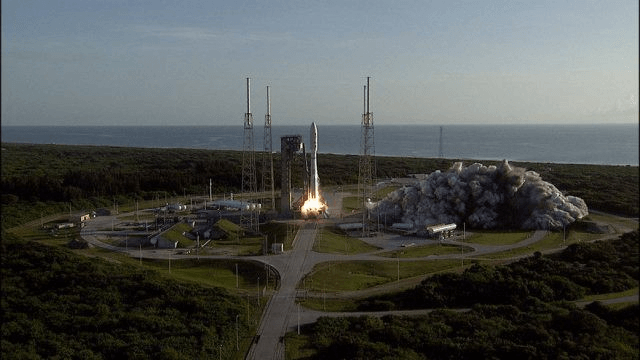今日推荐开源项目:《代码模板 Code-gen》
今日推荐英文原文:《NASA’s Latest Rover Is Now Headed for Mars》

今日推荐开源项目:《代码模板 Code-gen》传送门:GitHub链接
推荐理由:该项目是一款代码生成工具,可自定义模板生成各种不同的代码, Java8 环境即可。
今日推荐英文原文:《NASA’s Latest Rover Is Now Headed for Mars》作者:ExtremeTech
原文链接:https://medium.com/extremetech-access/the-power-of-perseverance-nasas-latest-rover-headed-for-mars-2afc70b4ed20
推荐理由:在我们“天问一号”启程的同时,人家也没闲着。7月30日, NASA 最新的火星探测器“毅力”(Perseverance)成功升空。如果一切顺利的话,它将在二月到达红色星球。值得一提的是,“毅力”上装载有名为 MOXIE 的火星氧气实验项目,试图利用火星上现有的大气产生少量氧气,为未来载人登陆提供氧气供应。
NASA’s Latest Rover Is Now Headed for Mars
by Joel Hruska
NASA announced a successful liftoff for its latest Mars rover, Perseverance (also known as the Mars 2020 Rover) on Thursday. If all goes well, the vehicle will reach the Red Planet in February.
At first glance, Perseverance looks like a repeat of Curiosity. The two spacecraft are built on a similar platform, but Perseverance has larger, more robust wheels with a larger diameter. These are intended to avoid the damage Curiosity has sustained during its time on Mars. Perseverance also carries MOXIE (Mars Oxygen ISRU Experiment), which will attempt to produce a small amount of oxygen using the existing atmosphere on Mars.

The MOXIE unit aboard Perseverance is a 1 percent scale model of a full-sized production plant. If the experiment is successful, it may mean astronauts traveling to the planet could use Mars’ atmosphere to create both breathable air and their own supply of propellant for the return trip. This would represent a substantial weight savings — most of the weight of a spacecraft is fuel, and any journey to another planet has to either carry the fuel for the return trip or make it at the destination. If MOXIE works, NASA could land an automated facility to begin creating oxygen before astronauts even arrive on Mars, ensuring a ready supply of available air from the moment they touchdown.

(The Perseverance rover. Credit: NASA)Perseverance also carries Ingenuity, a small (1.8kg / 4lb) helicopter intended to demonstrate the practicality of flight on Mars. Ingenuity doesn’t carry any scientific instruments, but it’s intended to scout potential routes for the rover and to demonstrate that flight on Mars is something we can accomplish remotely in the first place. Perseverance will also carry spacesuit samples to Mars to determine how they hold up to the rigors of the environment. Power is provided via an multi-mission radioisotope thermoelectric generator (MMRTG) containing enough plutonium to provide ~110W of power. The rover also carries two lithium-ion batteries to provide additional energy during peak requirements.
Both Perseverance and Curiosity use the same CPU, a RAD750 built by BAE. The RAD750 is based on the PowerPC 750, which debuted in 1997 as the CPU inside the original iMac. Once Perseverance arrives on Mars, PowerPC will dominate CPU deployments, with 60 percent of the total Mars rover market and 100 percent of the functional Mars rovers. Is this the spacecraft equivalent of being big in Japan?

(Jezero Crater. Image Credit: NASA/JPL-Caltech/MSSS/JHU-APL)In all seriousness, the reason NASA continues to send such underpowered hardware into space is due to radiation hardening. Newer CMOS processes tend to be more vulnerable than old ones, and for a rover on another planet, reliability is the top concern. We can afford to wait for Perseverance to spend a while crunching data. We can’t afford for its CPUs to be scrambled by incoming cosmic rays. Perseverance appears identical to Curiosity, with 256MB of onboard RAM, a backup BAE750 CPU in case the first fails, 2GB of onboard flash memory, 256MB of RAM, and a 256K EPROM. Clock speeds between the two rovers are identical, at 200MHz.

(The night before the Perseverance launch. Credit: NASA)One major difference between the two rovers is that Perseverance has the ability to drill into Martian rocks and extract core samples. These samples can then be analyzed and stored for future retrieval in an as-yet unplanned mission. The SuperCam unit is also a significant upgrade from the ChemCam aboard Curiosity and should be capable of assessing biosignatures and making a more thorough search of the environment for signs that Mars once supported life. It’s headed for Jezero Crater, which shows all the signs of having held a substantial body of water for a long period of time, making it one of the better places to search for life.
下载开源日报APP:https://openingsource.org/2579/
加入我们:https://openingsource.org/about/join/
关注我们:https://openingsource.org/about/love/
